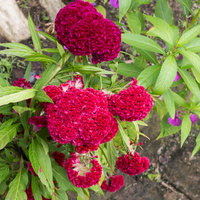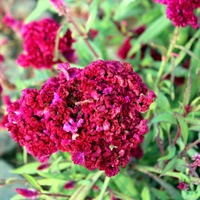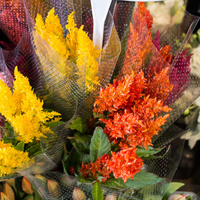Common name: Cockscomb
Other common names: Feather cockscomb, Lagos spinach, Plumeflower, Prince of wales feather, Quail grass, Red fox, Red spinach, Silver cockscomb
Description
Cockscomb is a herb originating from India with showy flowers and edible leaves that are cooked as a spinach vegetable.
It is an annual or short-lived perennial, depending on the growing conditions and produces a single unbranched stem up to 1.2 m (4 ft) tall bearing medium green lance-shaped leaves 3 to 10 cm (1.2 to 4 in) long.
The flowers are small and insignificant but are closely arranged in large, compact and showy flower-heads held erect above the plant. These come in plume- and crested- or cockscomb-shaped varieties up to 12 cm (5 in) in height and in a range of colours, from cream-white to yellow, orange, pink, red or crimson, depending on the cultivar. They are followed by very small round, black seed 1 mm (0.04 in) diameter.
Use
The leaves and young stems are cooked as a spinach, which is especially popular in tropical Africa. They are at their best when cooked lightly to retain their nutrition and appetising light green colour, and have a soft texture with an agreeable, mild spinach-like taste without bitterness.
Curiously, while moths and butterflies are attracted to the flowers, the
leaves contain compounds that discourage feeding by caterpillars. Hence, this is a good spinach-plant to grow in areas where leaf-eating caterpillars are a problem.
The flowering stems are used in floral arrangements. They are cut when the flowers are fully open, as they do not continue to open after they are harvested. The leaves near the base of the stem are stripped off before vasing so that they are not submerged in the vase water, which should have a floral preservative added and changed every one to two days. Varieties with long flowering stems and large flowerheads stand-out best in arrangements and have a vase life from five to seven days.
Both plume and cockscomb varieties can be dried for long-lasting arrangements. The stems are cut and hung with the flower-heads hanging down in an airy space until completely dry.
It is well-suited for growing in garden beds and containers, where the flowers add a vibrant colour.
Honeybees can be observed actively working the flowers, which produce good quantities of nectar, but their contribution to honey production is as yet unknown.
Health use
The cooked leaves and stems are a good source of iron, calcium and phosphorus, and the colourful flowers contain the pigment Anthocyanin, which has health-giving properties, though much of it is lost during the cooking process. The flowers are not usually cooked as they lose their colour and become an unappetising brown mess.
The dried flowers of the cockscomb variety, known in 'Ji guan hua' in China, are used in traditional Chinese medicine as a treatment against bleeding, including haemorrhoidal and abnormal uterine bleeding and nosebleeds, as well as treatment against diarrhoea. It is usually administered in the form of a powder, alcohol tincture or decoction. The seed of the plumed variety, known as 'Qing xiang zi', are made into decoctions, powders and pills, used to treat sore, red and inflamed eyes, high blood pressure and nosebleeds.
Climate
Grows naturally in moderately humid subtropical and tropical lowland to mid-elevation climates, generally in areas with annual lows of 10 to 25°C, annual highs of 20 to 35°C and annual rainfall of 700 to 2300 mm.
Growing
New plants are usually raised from seed. The seed are best sown in spring to early summer in subtropical areas and toward the end of the rainy season in tropical lowland areas (leading into the drier, cooler months), when there is sufficient soil moisture for good germination and growth, and when air humidity is at its lowest.
Flowering performance and yields of both leaves and seed are best on sites with full sun exposure, and on free-draining loam and sand soils enriched with well-rotted manure and compost, ideally with a moderately acid to slightly alkaline pH in the 6.0 to 7.5 range.
Problem features
The small seed are produced in abundance and are easily shaken from the seedhead by the wind. It is listed as a weed in at least one reference publication and has been classed as an invasive species, the most serious weed class. However, it is assessed as a low weed risk for Florida, by the IFAS Assessment of Non-Native Plants in Florida's Natural Areas.
Where it grows
References
Books
-
Adams, C. D. 1972, Flowering plants of Jamaica, University of the West Indies, Mona, Greater Kingston
-
Food and Agriculture Organization of the United Nations (FAO) 1988, Traditional food plants : a resource book for promoting the exploitation and consumption of food plants in arid, semi-arid and sub-humid lands of eastern Africa, Food and Nutrition Paper No. 42, Rome
-
Grubben, G.J.H. & Denton, O.A. (Editors) 2004, Plant Resources of Tropical Africa, Volume 2 : Vegetables, PROTA Foundation, Backhuys Publishers, Leiden
-
Hunter, N. T & Mitchell, H. 1994, The art of floral design, Delmar Publishers, Albany, New York
-
Jones, R. 2001, Caring for cut flowers, 2nd ed, Landlinks Press, Victoria, Australia
-
Leech, M. 2013, Bee Friendly: A planting guide for European honeybees and Australian native pollinators, Rural Industries Research and Development Corporation (RIRDC), Canberra, Australian Capital Territory
-
Mackey, B. & Brandies, M. M., 2001, A cutting garden for Florida : grow marvelous flowers for bouquets in your Florida home landscape, 3rd edition, revised and expanded, B.B. Mackey Books, Wayne, Pennsylvania
-
Martin, F. W & Ruberte, R. M. 1975, Edible leaves of the tropics, U.S. Agency for International Development (USAID), and the Agricultural Research Service, U.S. Department of Agriculture (USDA), Mayaguez, Puerto Rico
-
National Research Council (Board on Science and Technology for International Development) 2006, Lost Crops of Africa: Volume II: Vegetables, The National Academies Press, Washington D.C.
-
Parrotta, J. A. 2001, Healing plants of peninsular India, CABI Publishing, Wallingford, Oxfordshire
-
Randall, R. P. 2002, A global compendium of weeds, R.G. and F.J. Richardson Press, Melbourne
-
Schafer, Peg & Foster, Steven, 1957- & Fannin, Sean 2011, The Chinese medicinal herb farm : a cultivator's guide to small-scale organic herb production, Chelsea Green Pub, White River Junction, Vt
-
Seidemann, J. 2005, World spice plants: economic usage botany taxonomy, Springer-Verlag, Berlin
-
Tindall, H. D 1983, Vegetables in the Tropics, Macmillan Press, London
-
Tindall, H. D. & Rice, L. W. 1990, Fruit and vegetable production in warm climates, International ed., Macmillan, London




